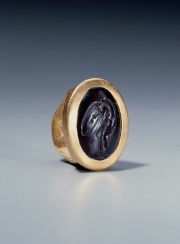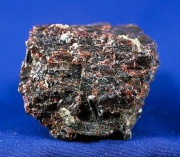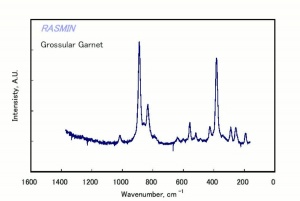Difference between revisions of "Garnet"
m (Text replace - "== Authority ==" to "== Sources Checked for Data in Record ==") |
|||
| Line 53: | Line 53: | ||
| − | == | + | == Sources Checked for Data in Record == |
* Jack Odgen, ''Jewellery of the Ancient World'', Rizzoli International Publications Inc., New York City, 1982 | * Jack Odgen, ''Jewellery of the Ancient World'', Rizzoli International Publications Inc., New York City, 1982 | ||
Revision as of 20:59, 30 April 2016
Description
A family of minerals composed of trisilicates with Aluminum, Iron, Calcium, Magnesium, Manganese, or Chromium. Garnets are found in deposits around the world as transparent crystals embedded in igneous and metamorphic rocks. They have been used as gemstones since antiquity. The ruby red Pyrope and the lighter red Almandine were the most highly prized varieties. The pale rose-purple Rhodolite is a mixture of pyrope and almandine. Garnets are also used as abrasives. The crushed, ground and cleaned garnet is sold as an abrasive powder, coated paper and coated cloth. Garnet particles have sharper cutting edges than aluminum oxide, but are expensive. To decrease costs, some commercially available garnet cloths are actually prepared with quartz. Sources of gem quality garnets include the Czech Republic, South Africa, Australia, China, India, Brazil, Sri Lanka, and the U.S (New York, Maine, Idaho).
Synonyms and Related Terms
pyrope (deep red to black); almandine (deep red to black); spessartine (red to brown); grossularite (green); grossular (colorless); carbuncle; andradite (wine red); uvarovite (emerald green); tsavorite (Green); rhodolite (pale red to purple); hessonite (golden); topazolite; demantoid; melanite; Uralian emeralds; Greek anthrax; Granat (Deut.); granate (Esp.); grenat (Fr.); granaat (Ned.); granada (Port.); granatus (Lat.)
Other Properties
Isometric crystal system with dodecahedron and trapezohedron habits.
Luster = vitreous to resinous. Fracture = conchoidal or uneven. Streak = colorless to white
Fluorescence = none (except green ones which may give weak yellow-orange colors)
| Mohs Hardness | 6.5 - 7.5 |
|---|---|
| Density | 3.52-4.32 |
| Refractive Index | 1.74-1.94 |
Additional Information
J. Ogden, Jewelry of the Ancient World, Rizzoli International Publications, New York, 1982.
Comparisons
Properties of Common Abrasives
Properties of Common Gemstones
Natural and Simulated Diamonds
Additional Images
Sources Checked for Data in Record
- Jack Odgen, Jewellery of the Ancient World, Rizzoli International Publications Inc., New York City, 1982
- R.F.Symmes, T.T.Harding, Paul Taylor, Rocks, Fossils and Gems, DK Publishing, Inc., New York City, 1997
- Encyclopedia Britannica, http://www.britannica.com Comment: "garnet" Encyclopædia Britannica [Accessed December 4, 2001]. (color photo)
- C.W.Chesterman, K.E.Lowe, Audubon Society Field Guide to North American Rocks and Minerals, Alfred A. Knopf, New York, 1979
- G.S.Brady, Materials Handbook, McGraw-Hill Book Co., New York, 1971 Comment: Mohs hardness = 8
- Van Nostrand's Scientific Encyclopedia, Douglas M. Considine (ed.), Van Nostrand Reinhold, New York, 1976
- Wikipedia, the free encyclopedia, at http://www.wikipedia.com Comment: http://en.wikipedia.org/wiki/Garnethtml (Accessed Sept. 7, 2005)
- CRC Handbook of Chemistry and Physics, Robert Weast (ed.), CRC Press, Boca Raton, Florida, v. 61, 1980 Comment: density=3.15-4.3
- R.M.Organ, Design for Scientific Conservation of Antiquities, Smithsonian Institution, Washington DC, 1968
- Michael McCann, Artist Beware, Watson-Guptill Publications, New York City, 1979



